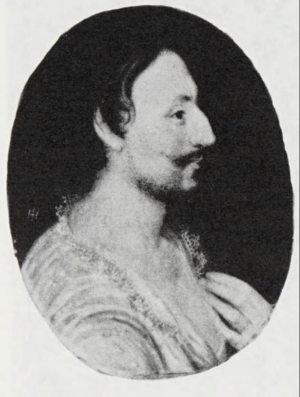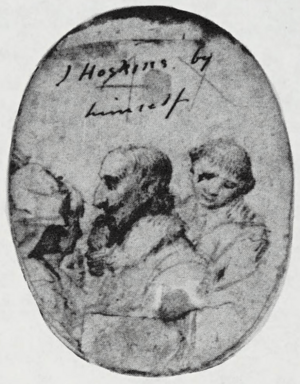John Hoskins (poet) facts for kids
Serjeant John Hoskins (born March 1, 1566 – died August 27, 1638) was an English poet, a smart scholar of Greek, a lawyer, a judge, and a politician. He was known for his sharp wit and his strong opinions.
Contents
Early Life and Education
John Hoskins was born in Mownton-upon-Wye, Llanwarne, Herefordshire. His parents were John and Margery Hoskins. His father was very impressed by young John's amazing memory and quick mind. Because of this, John started learning Greek when he was only ten years old.
He went to Westminster School for a year. After that, in 1579, he moved to Winchester College. From 1584 to 1588, he studied at New College, Oxford, which was connected to Winchester. He even arrived there at the same time as another famous person, Henry Wotton.
Starting His Career
John Hoskins was asked to leave Oxford University before he finished his studies. This happened because the university leaders didn't like his strong and sometimes funny satire (which means he made sharp jokes about things).
After leaving Oxford, he became a teacher in Ilchester, Somerset. While teaching, he started working on a huge Greek dictionary. He only got as far as the letter 'M'!
A lucky meeting changed his path. He met Benedicta Moyle, who later became his first wife. This meeting helped him get into the Middle Temple, a famous place where people studied to become lawyers.
Political Life and Challenges
By 1601, Hoskins bought a house in Hereford. He was then chosen to represent Hereford in the English Parliament in 1604 and again in 1614.
In 1614, while speaking in Parliament, he shared his strong opinions about an event called the Sicilian Vespers. Because he spoke his mind so freely, he was put in prison for a year. He was held in the Tower of London along with another important person, Sir Charles Cornwallis.
After he was released from prison, Hoskins continued his legal career. He became a Lent Reader in 1619, which was an important teaching role for lawyers. In 1623, he became a Judge. He was also re-elected as a Member of Parliament for Hereford in 1628.
Friends and Legal Skills
John Hoskins was good friends with many famous people of his time. These included the scholar John Selden, the explorer Sir Walter Raleigh, and the writer Ben Jonson.
He even had a duel (a planned fight) with Sir Benjamin Rudyard. But after their duel, they actually became very good friends!
Hoskins was a very skilled lawyer. Once, when he was a Serjeant-at-law (a high-ranking lawyer), he was accused of not keeping the sidewalk in front of his house in good repair. He successfully defended himself in court. He argued that the accusation didn't clearly say why he was responsible. He pointed out that it didn't say if he owned the property, lived there, or if someone else was supposed to take care of it.
Family Life
John Hoskins was married two times. His first wife was Benedicta Moyle. They met before he became a law student. However, they didn't marry until August 1, 1601. This was because Benedicta had first married Francis Bourne, another lawyer, who sadly passed away in February 1601.
John and Benedicta had three sons and one daughter. Sadly, two of their sons passed away before John did. Benedicta died on October 6, 1625.
His second wife was Isabel Riseley. They married on December 10, 1627. Isabel had been married twice before. John and Isabel did not have any children together.
Later Years and Passing
In early 1638, John Hoskins was attending a court session called assizes. During this time, a large country person accidentally stepped on his toe. This injury led to a serious infection called gangrene. Even though doctors tried to help by removing part of his leg, he passed away in August of that year. He was 72 years old.
John Hoskins was buried in Abbey Dore, Herefordshire. His son, Bennet Hoskyns, who survived him, later became a Baronet in 1676.
His Works
John Hoskins was a poet. A poem called Absence, Hear thou my Protestation was once thought to be written by John Donne, another famous poet. But now, many experts believe that John Hoskins actually wrote it. This poem was printed without an author's name in a collection called A poetical rhapsody in 1602.
Hoskins is also famous for painting an image called The Trusty Servant. This painting is an emblem (a symbol with a special meaning) that is outside the kitchen of Winchester College. He painted it in 1579. The emblem came with poems in both Latin and English that helped explain what the image meant.



